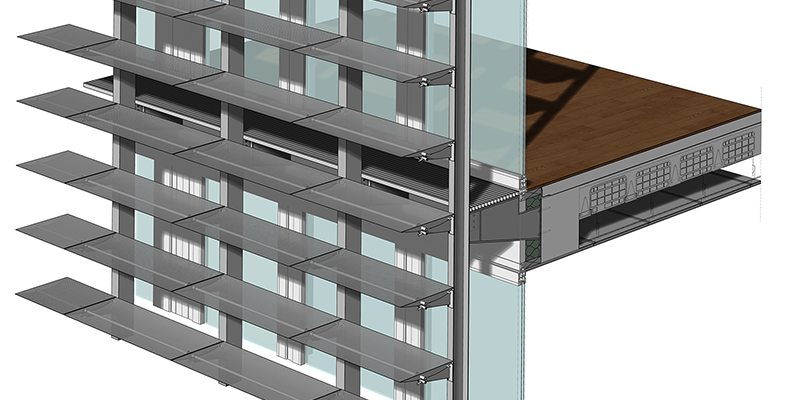Downloads
DOI:
https://doi.org/10.7480/jfde.2019.1.2778Keywords:
adaptive façade, parametric design, daylight, energy efficiency, building shellsAbstract
Energy savings and indoor comfort are widely considered to be key priorities in the current architectural design trends. Additionally, the well-being and satisfaction of end users is a relevant issue when a human-centred perspective is adopted. The application of Climate Adaptive Building Shells (CABS) compared to conventional façades offers appropriate opportunities for tackling these challenges. This paper reports the outcomes of a study performed on CABS in order to optimise the indoor comfort while calibrating the configuration of a dynamic façade module. The horizontal louvres of the adaptive façade are moved by an actuator that exploits the expansion of a thermo-active resin as it melts, by its absorption of energy. The actuation mechanism depends on the outdoor air temperature conditions and does not require a supply of energy. The performed simulation evidenced a decrease of approximately 4°C indoors when the dynamic module is fully efficient (21st June at 12 p.m.). Furthermore, the lux level is always within the comfort range for an office building (500-2000 lux) during both winter and summer scenarios. The optimised solution shows a substantial gain for energy performance and environmental sustainability. Moreover, the uniformity of distribution of daylight illuminance across the entire space is another associated advantage, giving interesting insights into potentials for architectural façade design.
How to Cite
Published
Issue
Section
License
Copyright (c) 2019 Adele Ricci, Caterina Ponzio, Jacopo Gaspari, Emanuele Naboni

This work is licensed under a Creative Commons Attribution 4.0 International License.
Authors or their institutions retain copyright to their publications without restrictions.
References
Ayman, H. A. M., & Yomna, E., (2016). Parametric-based designs for kinetic façades to optimize daylight performance: Comparing rotation and translation kinetic motion for hexagonal façade patterns. Solar Energy, vol. 126, pp. 111-127.
Barozzi, M., Lienhard, J., Zanelli, A.,& Monticelli, C. (2016). of the sustainability of adaptive envelopes: developments of kinetic architecture. Procedia Engineering, vol. 155, pp. 275-284.
Bayliss Autovents (n. d.), retrieved September 2017 from www.baylissautovents.co.uk.
Bluyssen, P.M., Aries, M., & Van Dommelen, P. (2011). Comfort of workers in office buildings: the European HOPE project. Building Environment, vol. 46, pp. 280-288.
Boake, T.M., (2014). Hot climate double façade: avoiding solar gain. Façades Tectonic, vol. 14 , pp. 2-24.
Boerstra, A.C., Beuker, T., Loomans, M.G.L.C.,& Hensen, J.L.M. (2013). Impact of available and perceived control on comfort and health in European offices. Architectural Science Review, vol. 56, issue 2.
Cole, R.J., & Brown, Z. (2009). Reconciling human and automated intelligence in the provision of occupant comfort. Intelligent Buildings International, vol.1.
David, M., Donn, M., Garde, F., & Lenoir, A.(2004). Assessment of the thermal and visual efficiency of solar shades. Building Environment, vol. 46, pp. 1489–1496.
Davidson, S. (2013). Grasshopper: Algorithmic Modelling for Rhino, NING/MODE, Brisbane, CA, USA. Retrieved from www.grasshopper3d.com.
Galasiu, A.D. & Veitch, J.A. (2006). Occupant preferences and satisfaction with the luminous environment and control systems in daylight offices: a literature review. Energy and Buildings, vol. 38, pp.728-742.
Godfried, A., (2011). The role of simulation in performance based building. Building Performance Simulation for Design and Operation. Abingdon: Spon Press.
Jakubiec J. A., & Reinhart C.F.(2011, November). Diva 2.0: Integrating daylight and thermal simulations using Rhinocers 3D, Daysim, and EnergyPlus, Proceedings of building simulations: 12th Conference of International Building Performance Simulation Association, Sydney, 14-16 November.
Keller, B., & Rutz S. (2010).Pinpoint: Key Facts + Figures for Sustainable Buildings. Basel:Birkhäuser.
Leung, C. (2014). Passive seasonally responsive thermal actuators for dynamic building envelopes, (Doctoral dissertation). Retrieved from The Bartlett School of Architecture University College London Database, London,
Loonen, R. (2010). Climate Adaptive Building Shells. What can we simulate? (Master’s thesis) University of Technology, Eindhoven.
Loonen, R.C.G.M., Trčka, M., Cóstola D., & Hensen J.L.M., (2010). Performance simulation of Climate Adaptive Building Shells - Smart Energy Glass as a case study, Proceedings of the 8th International conference on System Simulation in Buildings, pp. 1-19.
McNeel Europe (n. d.) , Food for Rhino, retrieved October, 2017 from www.food4rhino.com/app/ladybug-tools.
Nielsen, M.V., Svendsen S., & Bjerreg, L., (2011). Quantifying the potential of automated dynamic solar shading in office buildings through integrated simulations of energy and daylight. Solar Energy, vol 85, pp. 757–768.
Paciuk, M. (1989). The role of personal control of the environment in thermal comfort and satisfaction at the workplace.(Doctoral Dissertation). University of Wisconsin, Milwaukee.
Schumacher, M., Schaeffer, O, Vogt, M., (2010). Move: Architecture in Motion - Dynamic Components and Elements, Basel: Birkhäuser.
Shen H., & Tzempelikos, A., (2012). Daylighting and energy analysis of private offices with automated interior roller shades. Solar Energy, vol. 86, pp. 681–704.
UNI EN ISO 7726, (2002).Ergonomics of the thermal environment - Instruments for measuring physical quantities.
U.S. Department of Energy (n. d.), retrieved September 27, 2017 from www.energyplus.net/weatherlocation/europe_wmo_region_6/DNK//DNK_Copenhagen.061800_IWEC.
